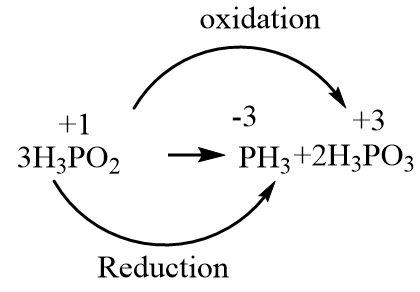
What is the
A.
B.
C.
D.
Answer
419.4k+ views
Hint: A disproportionation reaction is a special type of redox reaction in which a single chemical species is being oxidized as well as reduced. The phosphorus atom is the important part of the reaction as its oxidation number changes on going from reactant side to product side.
Complete answer:
The
Assign the oxidation numbers to phosphorus atoms in each reactant and product.

In order to find out the
a.Reduction half
b.Oxidation half
Since the electrons in both the half-reactions are not the same, the oxidation half needs to be multiplied by two to get the same number of electrons as the reduction half-reaction.
Now that the number of electrons are balanced, the two half-reactions can be added to verify that we get the same net balanced equation as before.
The net equation comes out to be the same, with the involvement of four electrons.
There are three molecules
The formula of
Putting the number of involved electrons as four and number of involved molecules as three in the above formula we get
Therefore, the correct option is option (C) with
Note:
All the reactants as well as products are neutral compounds, therefore the oxidation number of phosphorus atoms in each case can be determined by assuming it to be a variable and putting in the oxidation numbers of other atoms like oxygen and hydrogen. Simplifying the linear equation in one variable would give the oxidation states.
Complete answer:
The
Assign the oxidation numbers to phosphorus atoms in each reactant and product.

In order to find out the
a.Reduction half
b.Oxidation half
Since the electrons in both the half-reactions are not the same, the oxidation half needs to be multiplied by two to get the same number of electrons as the reduction half-reaction.
Now that the number of electrons are balanced, the two half-reactions can be added to verify that we get the same net balanced equation as before.
The net equation comes out to be the same, with the involvement of four electrons.
There are three molecules
The formula of
Putting the number of involved electrons as four and number of involved molecules as three in the above formula we get
Therefore, the correct option is option (C) with
Note:
All the reactants as well as products are neutral compounds, therefore the oxidation number of phosphorus atoms in each case can be determined by assuming it to be a variable and putting in the oxidation numbers of other atoms like oxygen and hydrogen. Simplifying the linear equation in one variable would give the oxidation states.
Latest Vedantu courses for you
Grade 11 Science PCM | CBSE | SCHOOL | English
CBSE (2025-26)
School Full course for CBSE students
₹41,848 per year
EMI starts from ₹3,487.34 per month
Recently Updated Pages
Master Class 11 Economics: Engaging Questions & Answers for Success

Master Class 11 Business Studies: Engaging Questions & Answers for Success

Master Class 11 Accountancy: Engaging Questions & Answers for Success

Master Class 11 English: Engaging Questions & Answers for Success

Master Class 11 Computer Science: Engaging Questions & Answers for Success

Master Class 11 Maths: Engaging Questions & Answers for Success

Trending doubts
State and prove Bernoullis theorem class 11 physics CBSE

1 ton equals to A 100 kg B 1000 kg C 10 kg D 10000 class 11 physics CBSE

State the laws of reflection of light

One Metric ton is equal to kg A 10000 B 1000 C 100 class 11 physics CBSE

Difference Between Prokaryotic Cells and Eukaryotic Cells

1 Quintal is equal to a 110 kg b 10 kg c 100kg d 1000 class 11 physics CBSE




